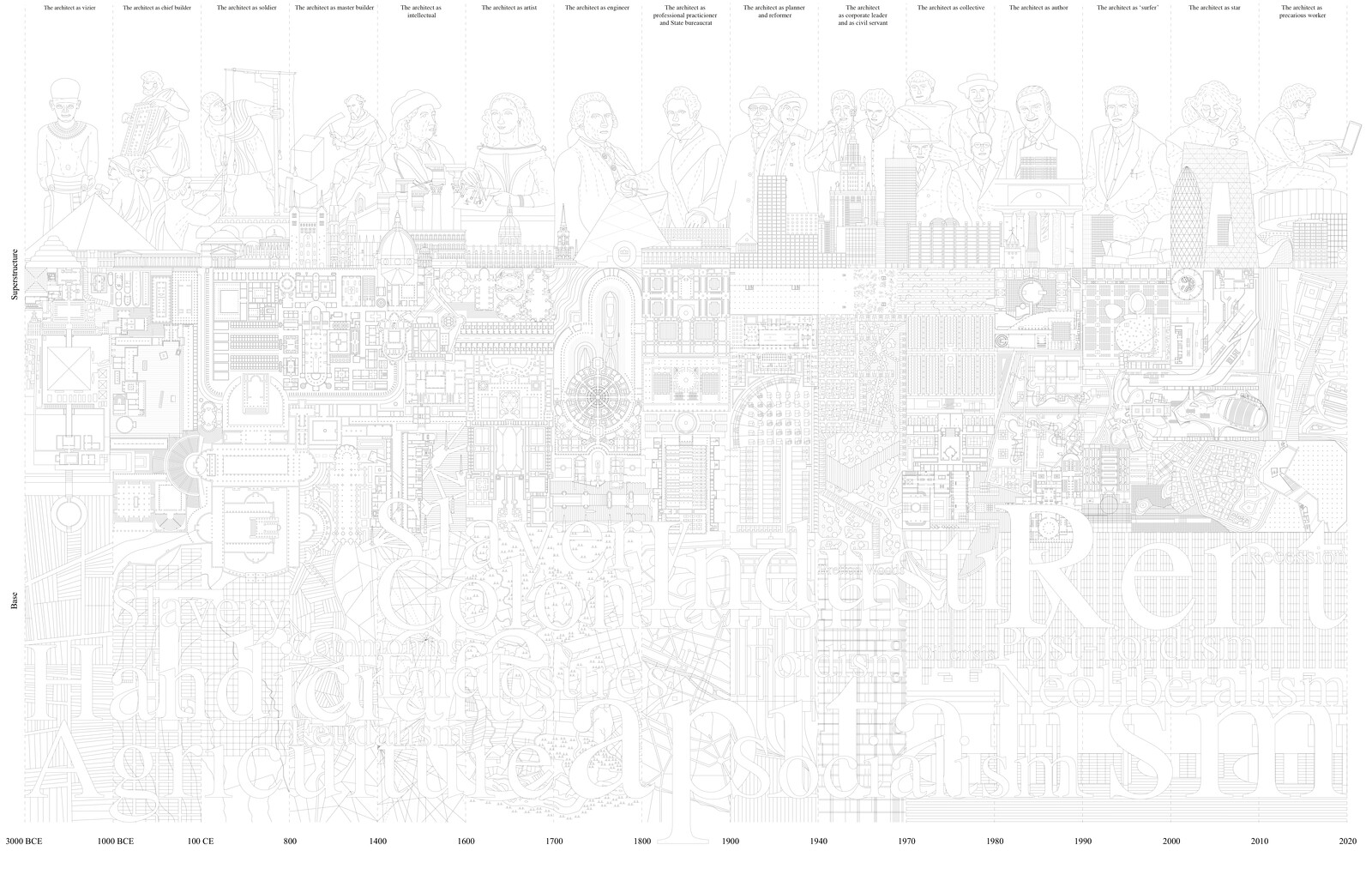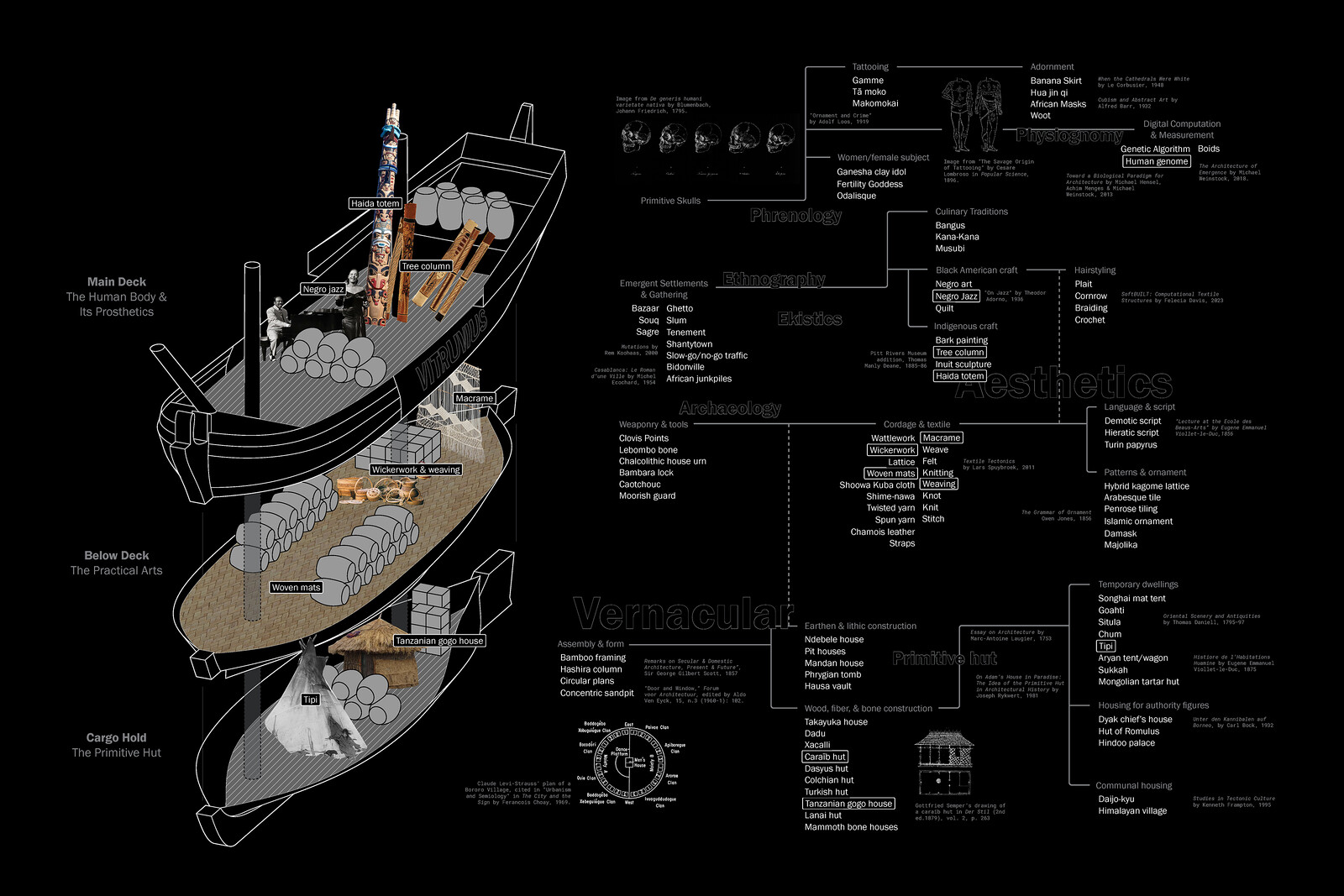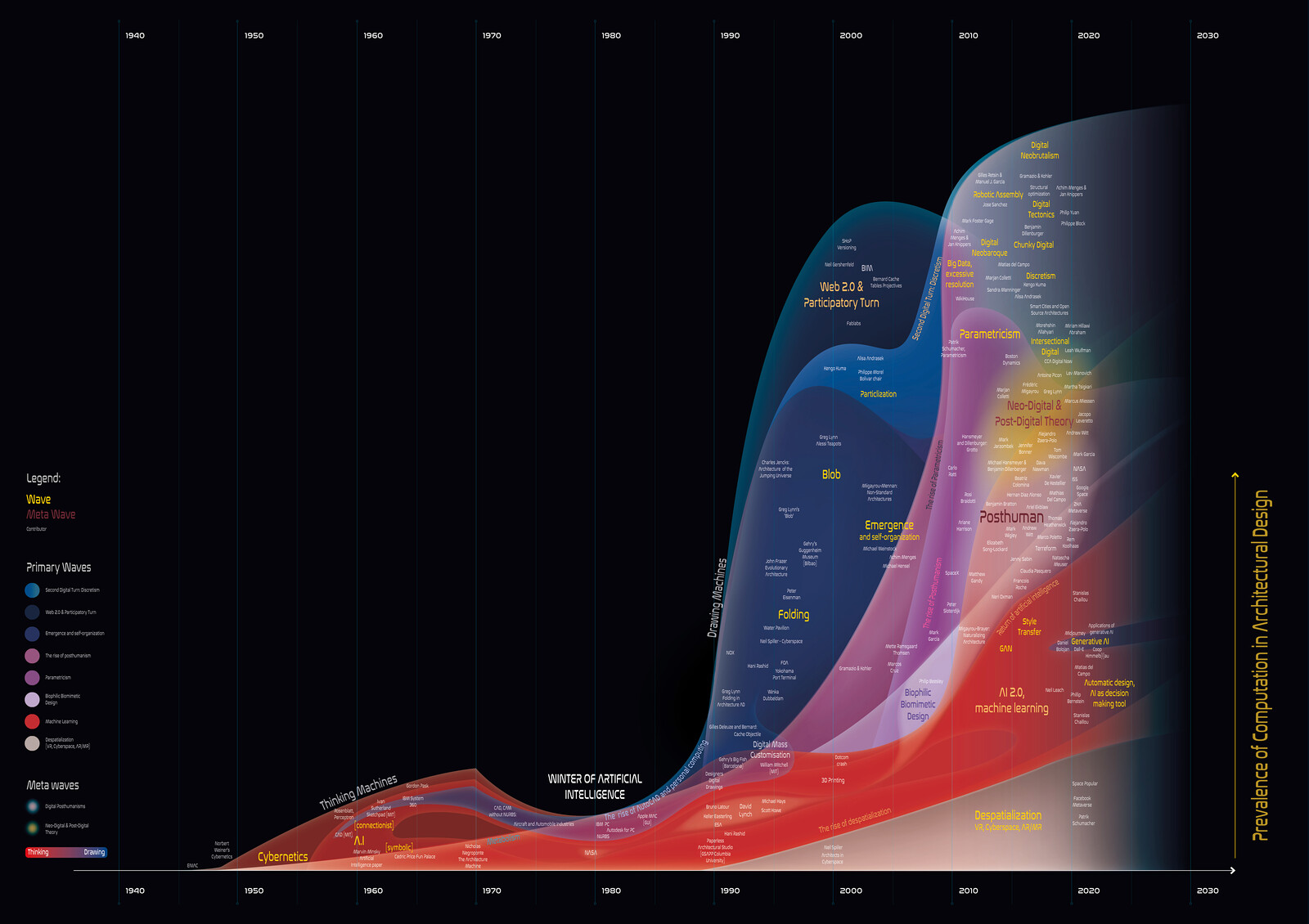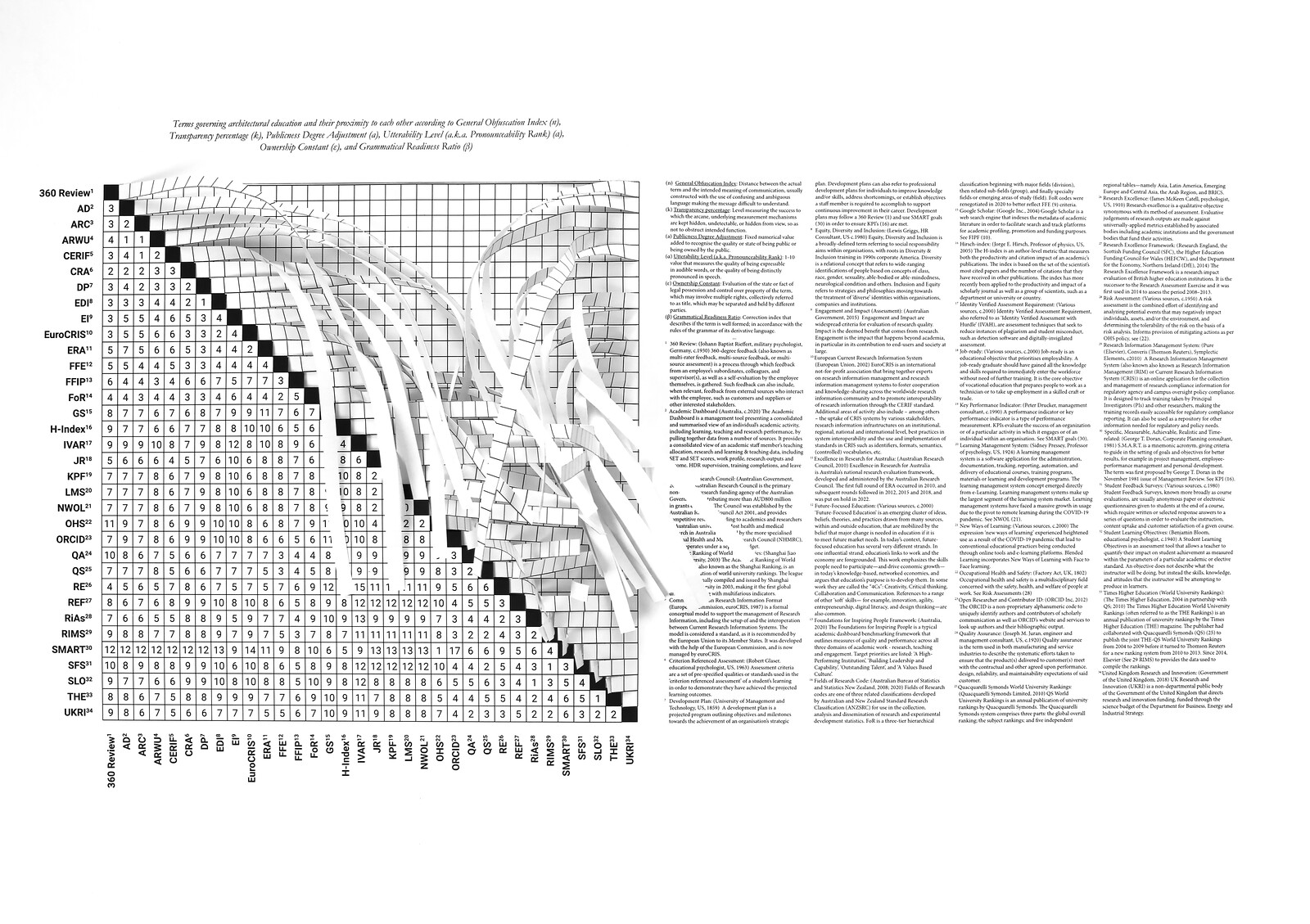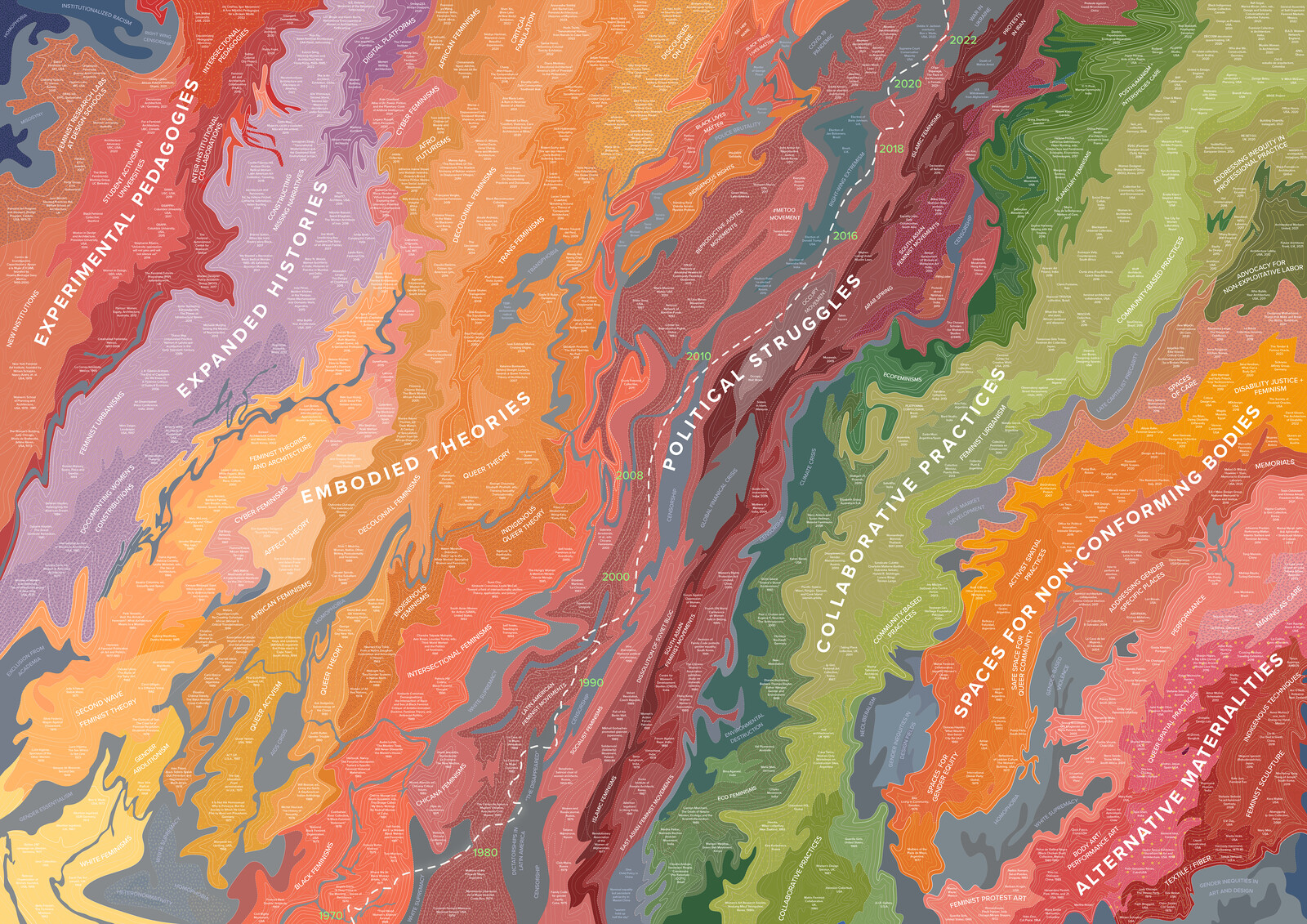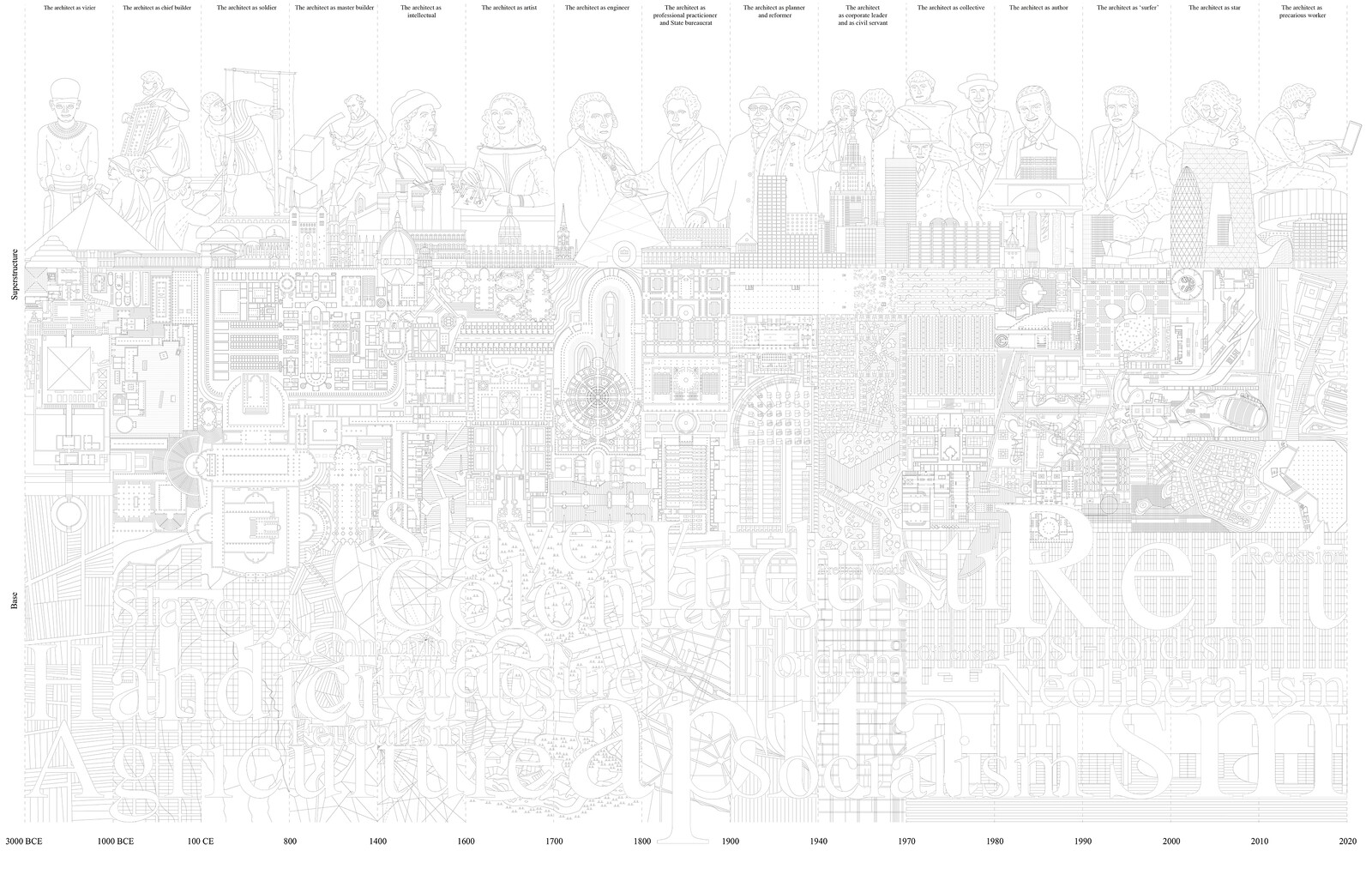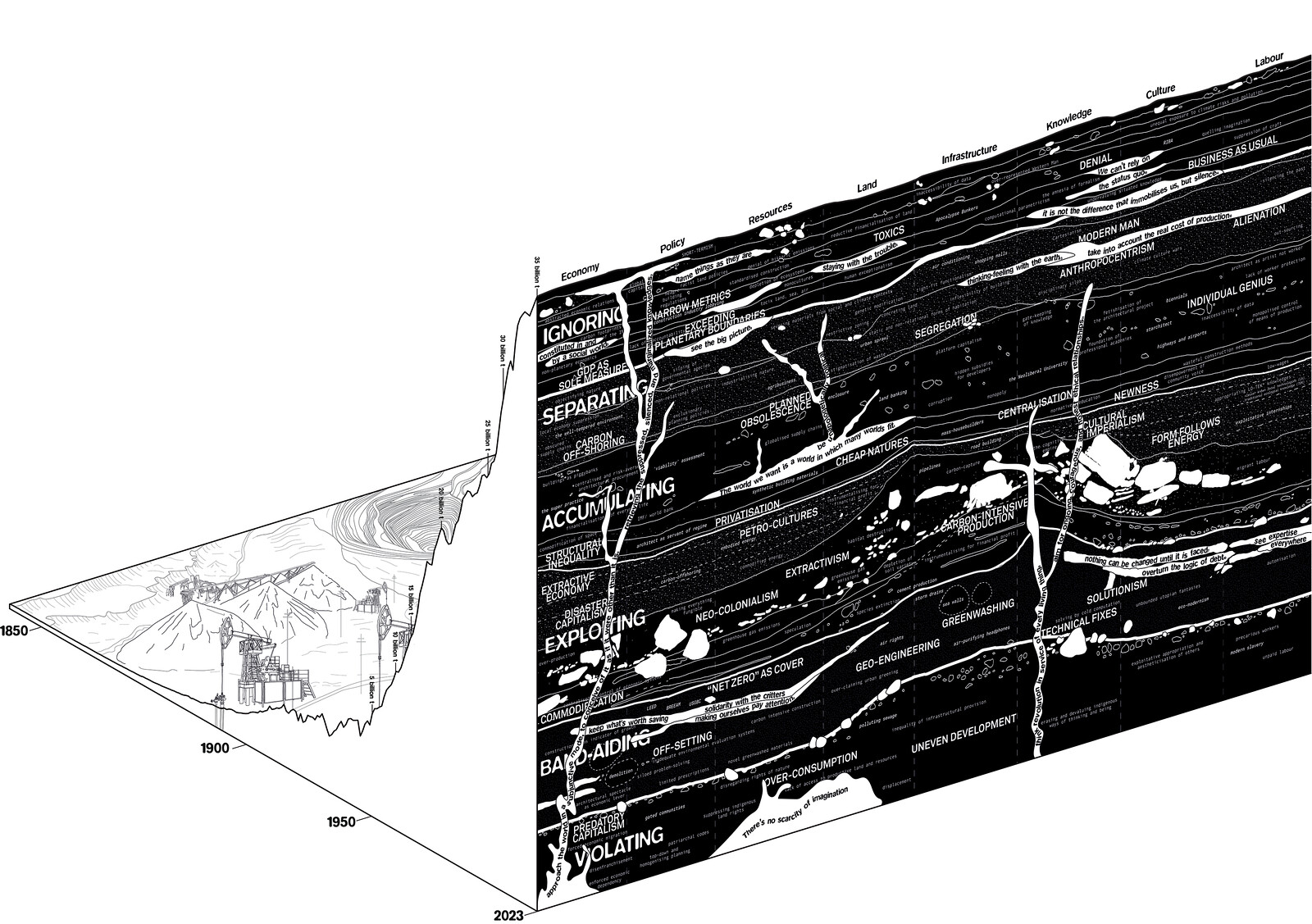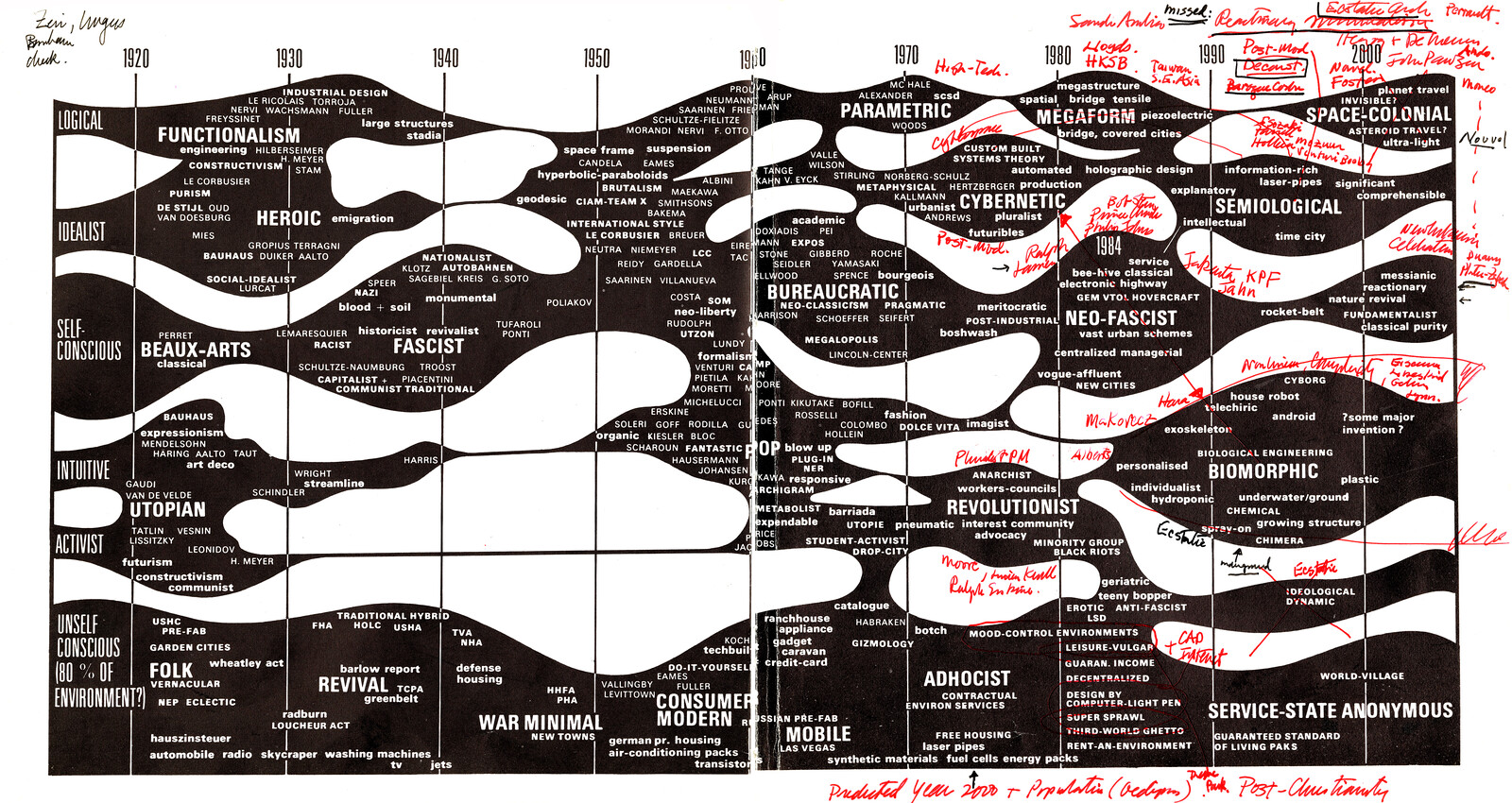It is well known that within Marxism the term “base” addresses the way in which human beings produce and reproduce themselves, while “superstructure” includes norms, cultural identities, professional roles, and politics that emerge as a consequence. Base is the mode of production, while superstructure is the ideology that legitimizes it. The relationship between base and superstructure is neither static nor neutral, but evolves over time and is used by the ruling class to exploit its subalterns. While in The German Ideology, Marx and Engels polemically emphasized how the base determined the superstructure,1 in his mature writings, Marx understood the relationship as dialectical, so that base shapes superstructure and vice-versa. However, as noted by Raymond Williams, Marx always located the origin point of worldviews or cultural imaginations in people’s productive activities, rather than in external forces or a general abstract consciousness.2
The goal of the diagram presented here is to offer a crude and concise history of Western architecture as a dialectic of base and superstructure. Such reading implies that architecture is ideology. From a liberal point of view (which is dominant within the historiography of architecture), the reading of cultural artifacts through the lens of base and superstructure is viewed with skepticism because their allegedly deterministic relationship seems to frustrate any form of autonomy and agency at the level of cultural production. Yet reading history—especially architectural history—as a dialectic between base and superstructure offers a direct and frank explanation of when certain architectures have been designed and built, and why.
This reading of architecture as ideology is based on Manfredo Tafuri’s seminal article “For a Critique of Architectural Ideology,” (1969) in which the Italian historian proposed to read architectural culture as the ideological sublimation of the conflicts and contradictions brought by the historical evolution of capitalism.3 For Tafuri, architecture is a never-ending “intellectual work” whose aim is to constantly innovate in order to cope with the technical and social innovations provoked by social and economic development. As noted by Felice Mometti, in Tafuri’s critique, architectural ideology does not merely legitimize the status quo by mystifying reality or false consciousness, but also is a political force that produces its own materiality in the form of symbolic codes, techniques of representation, constructions processes, divisions of labor, etc.4 The diagram expands Tafuri’s critique of ideology to trace base and superstructure before capitalism and up to its contemporary stage.
The diagram is organized through two registers. The bottom, the base, sets terms referring to different modes of production against a background of land use patters from different epochs. The upper, the superstructure, condenses a complicated apparatus made of material and immaterial factors into three sub-registers: architectural plans of representative artifacts, a skyline of iconic buildings, and the incarnations of architects. The diagram does not draw direct connections between specific modes of production and specific architectures or architect’s roles, but rather makes visible the historical proximities between them. It is up to the viewer to trace direct or indirect connections and resonances. For example, after the end of the neolithic age, many manifestations of large-scale monumental structures such as temples or pyramids can be interpreted as consequence of societies where agricultural surplus was appropriated by elites whose extractive capacity was organized through centralization and administration of religious and political power. Similarly, we can speculate how the geometric mastery that emerges from the subdivision of land into perfectly orthogonal parcels resonates with geometric virtuosity of ancient monuments.5
The goal of this diagram is to suggest how architecture’s disciplinary tradition is not (only) born from the imagination of builders, architects, and patrons. It reflects the way society is organized, its power relationships, and its social division of labor. It is for this reason that we have positioned the figure of the architect as the ideological pinnacle. In numerous instances, the professional role of the architect emerged or became empowered in times of intense commercial activity. The temples and other monumental structures that were built in Archaic and Classical Greece, for example, are inseparable from the competition of cities for economic and political hegemony in maritime trade. The medieval figure of the architect as a master builder who is distinguished from manual labor was a way to a control the building site on behalf of those who financed its construction. And in Renaissance Italy, when the valorization of real estate assets such as palaces and villas became a primary form of capital accumulation, the nascent ruling class sought to move away from the collective and collaborative ethos of guild-led building practices by empowering the architect as sole “project-leader.”
Descending from the ideological pinnacle of the architect to the architecture being designed and built, it is important to note how Renaissance architectural culture’s recuperation of ancient Roman structures as an examples of a “universal language” coincided with the beginning of European colonial expansion and violence, from Asia to the Americas, as well as the dispossession of both peasants and artisans of their means of production. The universalizing logic of what historian John Summerson called the “classical language of architecture,” which characterized European architecture from the fifteenth to the eighteenth century, can be understood as both a project of cultural hegemony by the landed class, and the sublimation of the imperialist and colonial economy of the early modern nation state.6
The development of capital into industry challenged the role of the architect. From the fifteenth to the seventeenth century, the architect was positioned as an intellectual or artist—as the author, or authority of architecture. But starting in the eighteenth century, the architect becomes positioned as an engineer, as someone whose technical skills and managerial capacity are in tune with the demands of industrial modes of production. It is at this point, under the pressure of both new building and engineering techniques and escalating social problems brough by capitalist growth, that the architect’s focus shifted from “form” to “reform.” Therefore, in the first half of the twentieth century, the architect became a social reformer; a figure that is no longer a individually recognizable, but instead is part of a large conglomerate of roles and competences, be it working directly for the state or within large private firms. Both the professional anonymity of the architect during this time and the relentless abstraction of late-modernist architecture can be interpreted as a consequence of welfare state policies whose aim was, at least in Europe, the partial decommodification of services such as housing, health and education.
With the decline of the welfare state and manufacturing in Europe and the United States and the rise of real estate as a major economic vector of development, the architect as social reformer is gradually replaced by the architect as famed author, with architecture acquiring a new centrality in the re-branding of cities as places of investment. The phenomenon of the so-called “starchitect,” whose job it is to design what Charles Jencks called the “iconic building,” is the ideological manifestation of a mode of production in which architecture serves as leverage for real estate profit.7 Far from being a social reformer or an expert in engineering and building techniques, the stararchitect is a marketing tool whose sole goal is the valorization of the architectural asset. Yet it would be a mistake to understand the rise of the stararchitect as a re-evaluation of the professional role of the architect tout-court. With the near disappearance of public commissioning, which left design and construction in the hands of market speculation, the job of the architect became radically proletarized to fit the logic of flexible accumulation typical of late capitalism. Consequently, the average architect has become a precarious worker, whose impoverishment is inversely proportional to the wealth they help to generate.
By addressing architecture as ideology does not mean that architecture is a superficial veneer that covers some real base at work. Architecture is not (only) false consciousness. To read architecture as ideology means to understand it as an artifice: a set of practices and principles that have both material and institutional consistency and which objectively contributes to the definition of people’s worldview. There will never be a world without ideology, just as there will never be a world without architecture. Crucial, then, is not to question architecture as ideology, but what sort of ideology architecture embodies.
In the diagram, the superstructure is drawn as a continuous field so that each artifact or figure loses its singularity and becomes part of a continuous stream of ideas, forms, concepts, images, meanings, symbols, principles, theories, and techniques. This non-stop architectural carpet, a reinterpretation of Giovanni Battista Piranesi’s Ichnographia Campi Martii (1756), aims to upset an overly mechanical reading of architecture as ideology. Ideology is a concrete and effective part of existence, but the way it articulates itself is not always easy to understand, especially in its dialectical exchange with the base. This is why critiques of architecture without a close-reading of architecture itself run the risk of creating nothing more than a smoke-screen, behind which the reproduction of ideology goes unchecked. Far from being a mirror that reflects the base, architecture as ideology is an opaque and labyrinthine substance, irreducible to any linear narrative, in which often God (or the devil) must be found in the detail.
Legend
Architects
A. Imhotep, 2650–2600 BCE.
B. Ictinus, 5th century BCE.
C. Marcus Vitruvius Pollio, 80–15 BCE.
D. Lanfranco, 11-12th Century.
E. Giuliano da Sangallo, 1445–1516.
F. Plautilla Bricci, 1616–1705.
G. Jean-Rodolphe Perronet, 1708–94.
H. Karl Friedrich Schinkel, 1781–1841.
I. Ludwig Hilberseimer, 1885–1967.
J. Margarete Schütte-Lihotzky, 1897–2000.
K. Gordon Bunshaft, 1909–90.
L. Valentina Pistoli, 1928–93.
M—P. Archizoom Associati, 1966–74.
M. Gilberto Corretti, 1941–.
N. Andrea Branzi, 1938–.
O. Massimo Morozzi, 1941–2014.
P. Paolo Deganello, 1940–.
Q. James Stirling, 1926–92.
R. Rem Koolhaas, 1944–.
S. Zaha Hadid, 1950–2016.
T. Anonymous, 1981–.
Column 1
1. White Temple, and Ziggurat, Uruk (modern Warka), Iraq, 3500 BCE.
2. Sacred City of Caral-Supe, Peru, 3000–1800 BCE.
3. Pyramid of Djoser, Saqqara, Egypt, 2670–2650 BCE.
4. Pyramid of Giza, Cairo, Egypt, 2550–2490 BCE.
5. Mortuary Temple of Hatshepsut, Luxor, Egypt, 1478–1458 BCE.
Column 2
6. House Unit 1, area 4, Nichoria (Messenia), Greece, 10th century BCE.
7. House Unit 5, area 4, Nichoria, 9th century BCE.
8. Dwellings in Smyrna, 8-7th century BCE.
9. Hecatompedon I, Samos, 8th century BCE.
10. Daphnephoros Temple, Eretria, ca. 8th century BCE.
11. Temple D, Eretria, ca. 8th cenutry BCE.
12. Temple of Apollo, Corinth, ca. 7th century BCE.
13. Altar of the Twelve Gods, Agora of Athens, 522-1 BCE.
14. Stoa Basileios (Royal Stoa), Agora of Athens, 500 BCE.
15. Stoa Poikile, Agora of Athens, ca. 500–450 BCE.
16. New Bouleuterion, Agora of Athens, 5th century BCE.
17. Tholos, Agora of Athens, ca. 470 BCE.
18. Temple of Atena Parthenos (Parthenon), 447–432 BCE.
19. Propylaea, Acropolis of Athens, 437–432 BCE.
20. Stoa of Zeus Eleutherios, Agora of Athens, 430-425 BCE.
21. Monument of the Eponymous Heroes, Agora of Athens, 430 BCE.
22. Iktinos, Telesterion of Demeter, Eleusis, 5th century BCE.
23. Temple of Athena Nike, 426–421 BCE.
24. Temple of Athena Polias (Erechtheion), 406 BCE.
25. Metroon, Agora of Athens, 2nd century BCE.
26. Middle Stoa, Agora of Athens, ca. 180–140 BCE.
27. Temple of Olympian Zeus, Athens, 174–132 BCE.
28. Stoa of Attalos, Agora of Athens, 150 BCE.
29. Bouleuterion of Miletus, ca. 175–164 BCE.
30. Theatre of Epidaurus, Argolid Peninsula, 4th century BCE.
Column 3
31. Mausoleum of Augustus, Rome, 28 BCE.
32. Roman aqueduct of Pont du Gard (Nîmes), 1st century CE.
33. Roman castrum of Inchtuthil, Scotland, 83 CE.
34. Trajan’s Forum, Rome, 112 CE.
35. Temple of Minerva Medica, Rome, 4th century CE.
Column 4
36. Aachen Cathedral, 796.
37. Plan for an Ideal Benedictine Monastery, library of St. Gall, Switzerland, 820-830.
38. Princely Abbey of Corvey, Germany, 822.
39. Plan of a Cistercian Monastery, 12th century.
40. Basilica of Saint-Denis, France, 1135.
41. Castel del Monte, Andria, Italy, 1240.
Column 5
42. Filippo Brunelleschi, Ospedale degli Innocenti, Florence, 1418-19.
43. Filippo Brunelleschi, Dome of Santa Maria del Fiore, Florence, 1420.
44. Filippo Brunelleschi, Santa Maria degli Angeli, Florence, 1434.
45. Francesco di Giorgio Martini, Rocca Ubaldinesca, Sassocorvaro Auditore, Italy 1475.
46. Antonio da Sangallo the Elder and Antonio da Sangallo the Younger, Fortress, Civita Castellana, Italy, 1495.
47. Benedetto da Maiano, Giuliano da Sangallo, Simone del Pollaiolo, Baccio d’Agnolo, Palazzo Strozzi, Florence, 1489–1538.
48. Donato Bramante, Tempietto, Rome, 1502.
49. Antonio da Sangallo the Younger and Michelangelo Buonarroti, Palazzo Farnese, Rome, 1515.
50. Sebastiano Serlio, Architectural Orders, in ‘Quarto Libro’, 1537.
51. Andrea Palladio, Villa Emo, Fanzolo, Italy, 1559–1565
52. Giorgio Vasari, Uffizi, Florence, 1560–81.
53. The Planning of Baroque Rome by Sixtus V, 1585–90.
Column 6
54. Francesco Grimaldi, Church Sant’Andrea della Valle, Rome, 1590–1650.
55. Pierre Le Muet, Houses from, Manière de bastir pour touttes sortes de personnes, 1623.
56. Francesco Borromini, Church of San Carlo alle Quattro Fontane, Rome, 1634–35.
57. Francesco Borromini, Church of Sant’Ivo alla Sapienza, Rome, 1643.
58. Gian Lorenzo Bernini, Church of Sant’Andrea al Quirinale, 1658.
59. Carlo Rainaldi, Church of Santa Maria in Portico in Campitelli, 1662.
60. Gian Lorenzo Bernini, Project for the Louvre, Paris, 1664–65.
61. Libéral Bruant, Jules Hardouin Mansart, Hôtel national des Invalides, Paris, 1676–1691.
Column 7
62. Nicholas Hawksmoor, Christ Church Spitalfields, 1714–29.
63. Antoine Choquet de Lindu, Dry docks in the Arsenal of Brest, France, 1757.
64. Giovanni Battista Piranesi, Ampio Magnifico Collegio (Large Magnificent college), 1750.
65. Pierre Patte, Project for an ideal street, 1769.
66. Jean-Rodolphe Perronet, Project for a Bridge on the Seine, Paris, 1782.
67. Étienne-Louis Boullée, Cénotaphe, 1790s.
68. Claude-Nicolas Ledoux, La Maison des directeurs de la Loue, 1804.
Column 8
69. Jean-François de Neufforge, Project for a hospital, 1757–80.
70. Jean-Nicolas-Louis Durand, Project for a Museum, 1802.
71. Karl Friedrich Schinkel, Altes Museum, Berlin, 1823–28.
72. Thomas Jefferson, University of Virginia, Charlottesville, USA, 1817–25.
73. Factory and mill in Manchester, 1826.
74. Sidney Stott, Minerva Mill, (Ashton-under-Lyne) Manchester, 1890.
Column 9
75. Albert Kahn, Ford Motor Company Plant, Highland Park, Detroit, 1909–10
76. Heinrich Tessenow, Festspielhaus, Hellerau, Germany, 1911.
77. Ludwig Hilberseimer, Vertical City, 1914.
78. Warren & Wetmore, The Commodore Hotel, New York, 1919.
79. Ludwig Hilberseimer, Chicago Tribune Headquarters, Chicago, 1922.
80. Bruno Taut, Hufeisensiedlung Grossiedlung, Berlin, 1924–30.
81. Alexander Klein, Diagrams of minimal family apartments, 1928.
82. Mart Stam, Hellerhof-Siedlung, Frankfurt, 1929.
83. Moisei Ginzburg, Prototype of Dom-Kommuna with F-1 apartment units, Moscow, 1929.
Column 10
84. Le Corbusier, Unité d’Habitation, Marseille, 1947–52.
85. Lev Rudnev, Moscow State University, 1947–53.
86. Gordon Bunshaft and Natalie de Blois (SOM), Lever House, New York, 1951.
87. Walter Henn, Osram GmbH Admin building, Munich 1962, Bürolandschaft model, 1950s.
88. Saverio Muratori and Mario de Renzi, INA Casa in Tuscolano, Rome, 1952–56.
89. Jacques Henri-Labourdette and Roger Boileau, The grand ensemble of Sarcelles, 1955–57.
90. Ludwig Mies van der Rohe, Seagram Building, 1958.
91. Siegfried Nassuth, The Bijlmermeer, Amsterdam, 1965.
92. Vittorio Bonadè Bottino, Mirafiori FIAT Factory, Torino, 1968.
Column 11
93. Archizoom Associati, No-Stop City, 1968–72.
94. Vittorio Gregotti, Housing Complex Zen 2, Palermo, 1969–73.
95. Aldo Rossi, Salvatore Orrù elementary school, Fagnano Olona, Italy, 1972–76.
96. Renzo Piano and Richard Rogers, Centro Pompidou, 1971–77.
97. Louis Kahn, Kimbell Art Museum, Fort Worth, USA, 1972.
98. OMA, Welfare Palace Hotel, New York, 1978.
Column 12
99. Aldo Rossi, Teatro del Mondo, Venice, 1979.
100. James Stirling, Neue Staatsgalerie, Stuttgart, 1979–84.
101. Hans Hollein, Facade for Strada Novissima, Venice Architecture Biennale, 1980
102. Jean Nouvel, Institut du Monde Arabe, Paris 1981–87.
103. Philip Johnson and John Burgee, 550 Madison Avenue Tower, New York, 1981–84.
104. Bernard Tschumi, Parc de la villette, Paris 1982–98.
105. Micheal Graves, Denver Public Library, 1989–95.
Column 13
106. Dominique Perrault, Biblioteque Nationale, Paris, 1989–95.
107. OMA, Très Grande Bibliothèque, 1989.
108. Frank Gehry, Walt Disney Concert Hall, Los Angeles, USA, 1991.
109. Frank Gehry, Guggenheim Museum, Bilbao, 1993–97.
110. OMA, New Seoul International Airport, 1995.
Column 14
111. Foster+Partners, 30 St Mary Axe, London, 1997–2004.
112. Zaha Hadid, MAXXI: Museum of XXI Century Arts, Rome, 1998-2009.
113. OMA, CCTV – Headquarters, Beijing, 2002–12.
114. Stefano Boeri, Villa Méditerranée, Marseille, 2004–13.
115. Massimiliano Fuksas, Roma Convention Center ‘La Nuvola’, Rome, 2008–16.
116. Ai Weiwei, Masterplan for Ordos 100, Ordos, China, 2008.
Column 15
117. SBB, Municipality of Zurich, Masterplan development of Europallee, Zurich, Switzerland, 2004–2022.
118. Caruso St John Architects, Europaallee Mixed-use Building, 2007–13.
119. Zaha Hadid, Heydar Aliyev Cultural Centre, Baku, Azerbaijan, 2007–12.
120. The Masterplan of Battersea Power Station, London, 2012.
121. Gigafactory Nevada, Reno, USA, 2013.
122. MVRDV, Markthall, Rotterdam, 2014.
123. Christ & Gantenbein, Swiss National Museum, Zurich, 2016.
124. Office KGDVS, Tondo, Brussels, Belgium, 2017.
125. Valerio Olgiati, Office tower of Baloise insurance company, Basel, Switzerland, 2021.
Base
I. Sumerian ‘Long Field’, Mesopotamia, 4000 BCE.
II. Greek city of Priene, 4th century BCE.
III. Roman centuriation between Padua and Venice, ca. 1st century BC.
IV. Open Field System in England, between 850 and 1150.
V. Portolan Chart of the Mediterranean Sea, 1500s.
VI. Thomas Holme, Map of the Improved Part of Pennsylvania in America, 1682.
VII. Georges-Eugène Haussmann, Renovation plan of Paris, 1853–70.
VIII. Louis I. Kahn, Traffic Study, Philadelphia, 1952.
IX. Albert Kahn, Ford Highland Park, Detroit, 1914.
X. Container Terminal, Port of Rotterdam, 1970–2015.
Karl Marx, Friedrich Engels, Collected Works, 1845-47, vol. 5 (New York: International Publisher, 1976), 36-37.
Raymond Williams, Problems in Materialism and Culture (London: Verso, 1985), 28.
Manfredo Tafuri, “Per una Critica dell’ideologia architettonica” in Contropiano 1 (1969), 31-79; translated by Stephen Sartarelli as “Towards a Critique of Architectural Ideology” in K. Michael Hays, ed. Architecture Theory since 1968 (Cambridge, Ma.: The Mit Press), 6-35.
Felice Mometti, ‘Ideologia come Architettura. Manfredo Tafuri e la storia critica’ in Scienza e Politica Vol. 24 N. 47 (2012), ➝.
These issues are elaborated in Pier Vittorio Aureli, Architecture and Abstraction (Cambridge, Ma.: The Mit Press, 2023).
John Summerson, The Classical Language of Architecture (Cambridge, Ma.: The Mit Press, 1966).
Charles Jencks, The Iconic Building (New York: Rizzoli, 2005).
Chronograms of Architecture is a collaboration between e-flux Architecture and the Jencks Foundation within the context of their research program “‘isms and ‘wasms.”
